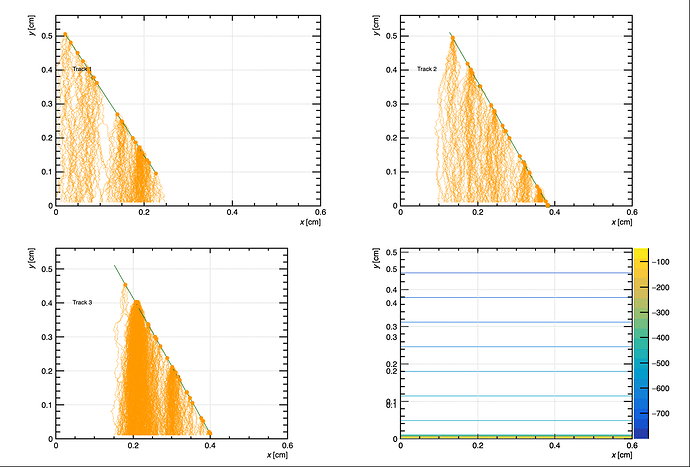Hello everyone,
I am working on a simulation with Garfield++ where I want to analyze the microscopic details of the ionization process, particularly focusing on the secondary ionization generated during the avalanche process. I want to ensure that all electrons, including those produced by ionization (delta electrons), are correctly tracked and contribute to the signal.
(Picture: I am attempting to simulate the drift and avalanche of electrons produced along a track. While the drift lines are visualized correctly, I am having issues with the secondary ionization process and how to properly collect and visualize avalanche electrons.)
Here’s a snippet of my code:
#include <iostream>
#include <cmath>
#include <TApplication.h>
#include <TCanvas.h>
#include "Garfield/ViewField.hh"
#include "Garfield/ViewDrift.hh"
#include "Garfield/ViewSignal.hh"
#include "Garfield/MediumMagboltz.hh"
#include "Garfield/ComponentAnalyticField.hh"
#include "Garfield/Sensor.hh"
#include "Garfield/TrackHeed.hh"
#include "Garfield/AvalancheMicroscopic.hh"
#include "Garfield/Plotting.hh"
using namespace Garfield;
int main(int argc, char * argv[])
{
TApplication app("app", &argc, argv);
plottingEngine.SetDefaultStyle();
// Set the gas mixture.
MediumMagboltz gas;
gas.SetComposition("ar", 93., "co2", 7.);
// gas.SetComposition("ar", 90., "c4h10", 10.);
// Build the Micromegas geometry.
// We use separate components for drift and amplification regions.
ComponentAnalyticField cmpD;
ComponentAnalyticField cmpA;
cmpD.SetMedium(&gas);
cmpA.SetMedium(&gas);
// Set the magnetic field [Tesla].
constexpr double bfield = 0.;
cmpD.SetMagneticField(0, 0, bfield);
cmpA.SetMagneticField(0, 0, bfield);
// 100 um amplification gap.
constexpr double yMesh = 0.01;
constexpr double vMesh = -500.0;
cmpA.AddPlaneY(yMesh, vMesh, "mesh");
cmpA.AddPlaneY(0.0, 0.0, "bottom");
// 3 mm drift gap.
constexpr double yDrift = yMesh + 0.3; // cm
constexpr double vDrift = -800.0; // Volt
cmpD.AddPlaneY(yDrift, vDrift, "top");
cmpD.AddPlaneY(yMesh, vMesh, "mesh");
// We place three strips along z direction on the anode plane
// in order to be able to resolve the avalanche signal.
// Strip pitch [cm].
constexpr double pitch = 0.05;
// Distance between two strips [cm].
constexpr double interstrip = 0.01;
// Half-width of a strip.
constexpr double hw = 0.5 * (pitch - interstrip);
const double xStrip1 = hw;
cmpA.AddStripOnPlaneY('z', 0., xStrip1 - hw, xStrip1 + hw, "strip1");
const double xStrip2 = xStrip1 + pitch;
cmpA.AddStripOnPlaneY('z', 0., xStrip2 - hw, xStrip2 + hw, "strip2");
const double xStrip3 = xStrip2 + pitch;
cmpA.AddStripOnPlaneY('z', 0., xStrip3 - hw, xStrip3 + hw, "strip3");
const double xStrip4 = xStrip3 + pitch;
cmpA.AddStripOnPlaneY('z', 0., xStrip4 - hw, xStrip4 + hw, "strip4");
// We want to calculate the signals induced on the strips.
cmpA.AddReadout("strip1");
cmpA.AddReadout("strip2");
cmpA.AddReadout("strip3");
cmpA.AddReadout("strip4");
// Assemble a sensor.
Sensor sensor;
sensor.AddComponent(&cmpD);
sensor.AddComponent(&cmpA);
sensor.SetArea(0., 0., -1., 6 * pitch, yDrift, 1.);
// Request signal calculation for the strip electrodes.
sensor.AddElectrode(&cmpA, "strip1");
sensor.AddElectrode(&cmpA, "strip2");
sensor.AddElectrode(&cmpA, "strip3");
sensor.AddElectrode(&cmpA, "strip4");
// Set the time window [ns] for the signal calculation.
const double tMin = 0.;
const double tMax = 100.;
const double tStep = 0.05;
const int nTimeBins = int((tMax - tMin) / tStep);
sensor.SetTimeWindow(0., tStep, nTimeBins);
// We use microscopic tracking for simulating the electron avalanche.
AvalancheMicroscopic aval;
aval.SetSensor(&sensor);
// Switch on signal calculation.
//aval.EnableSignalCalculation();
aval.EnableSignalCalculation(true);
aval.UseWeightingPotential(true);
aval.EnableWeightingFieldIntegration(true);
aval.UseInducedCharge(true);
aval.EnableDriftLines(true);
aval.EnableMagneticField();
aval.SetElectronTransportCut(0.0);
// Simulate an ionizing particle (negative pion) using Heed.
TrackHeed track;
track.SetParticle("mu-");
constexpr double momentum =300.e6; // [eV / c]
track.SetMomentum(momentum);
track.SetSensor(&sensor);
track.EnableMagneticField();
// track.EnableElectricField();
track.EnableDeltaElectronTransport();
track.Initialise(&gas, true);
// Construct a viewer to visualise the drift lines.
ViewDrift driftView;
track.EnablePlotting(&driftView);
aval.EnablePlotting(&driftView);
aval.EnableExcitationMarkers(true);
aval.EnableIonisationMarkers(true);
aval.EnableAttachmentMarkers(true);
// Set the starting point of the incoming ionising track.
double xt = 0.1; // [cm]
double yt = yDrift;
double zt = 0.0;
// Now simulate a track.
track.NewTrack(xt, yt, zt, 0.87, 0.5, -1, 0);
// Loop over the clusters.
double xc, yc, zc, tc, ec, extra;
int nc;
while (track.GetCluster(xc, yc, zc, tc, nc, ec, extra))
{
for (int j = 0; j < nc; ++j)
{
double xe, ye, ze, te, ee, dxe, dye, dze;
track.GetElectron(j, xe, ye, ze, te, ee, dxe, dye, dze);
// Simulate the drift/avalanche of this electron.
aval.AvalancheElectron(xe, ye, ze, te, 100.0, dxe, dye, dze);
}
}
